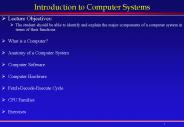COMPUTER FUNDAMENTAL - PowerPoint PPT Presentation
1 / 16
Title:
COMPUTER FUNDAMENTAL
Description:
16 megabytes (MB) of memory. Hard disk space may range from between 120 MB and 295 MB ... 128 megabytes (MB) of RAM (64 MB minimum supported; may limit ... – PowerPoint PPT presentation
Number of Views:44
Avg rating:3.0/5.0
Title: COMPUTER FUNDAMENTAL
1
COMPUTER FUNDAMENTAL
2
What is computer and what does it do?
A computer is an electronic machine, operating
under the control of instructions stored in its
own memory, that can accept data (input),
manipulate the data according to specified rules
(process), produce results (output), and store
the result for future use (storage).
3
Computer Software
- Is a series of instructions that tells the
hardware of a computer what to do. - 3 types of computer software
- Operating system (Windows, Linux, Unix)
- Application software
- (Microsoft Word, Microsoft Excell)
- Programming Language (COBOL, C)
4
Operating System
- Is a series of instructions that tells the
hardware of a computer what to do. The operating
system (OS) contains instructions that coordinate
all of the activities of hardware devices. - OS also contains instructions that allow user to
run application software.
5
How the OS works?
- When you start a computer, the OS is loaded, or
copied, into memory from the computers hard
disk. It remains in memory while the computer is
running and allows you to communicate with the
computer and other software.
6
Application Software
- Application software consists of programs
designed to perform specific tasks for users. - Example
- Word processing software allows you to create
documents such as letters and memos. - Spreadsheet software allows you to calculate
numbers arranged in rows and columns. - Presentation graphics software allows you to
create documents called slides that are used in
making presentations.
7
Firmware
- Data, information and instructions that contained
permanently in ROM chips. - These instructions stored on ROM chips often are
recorded when the chip is manufactured.
8
VIRUS
- Computer viruses are small software programs that
are designed to spread from one computer to
another and to interfere with computer operation.
- A virus might corrupt or delete data on your
computer, it uses e-mail program to spread itself
to other computers, or even erase everything on
your hard disk.
9
SPAM
- Spam is flooding the Internet with many copies of
the same message, in an attempt to force the
message on people who would not otherwise choose
to receive it. Most spam is commercial
advertising, often for dubious products,
get-rich-quick schemes, or quasi-legal services.
Spam costs the sender very little to send -- most
of the costs are paid for by the recipient or the
carriers rather than by the sender.
10
SPYWARE
- Spyware is any technology that aids in gathering
information about a person or organization
without their knowledge. On the Internet (where
it is sometimes called a spybot or tracking
software), spyware is programming that is put in
someone's computer to secretly gather information
about the user and relay it to advertisers or
other interested parties. - Spyware can even change computer settings,
resulting in slow connection speeds, different
home pages, and loss of Internet or other
programs.
11
Antivirus Software
- An antivirus program is a utility that prevents,
detects, and removes viruses from a computers
memory or storage devices.
12
HARDWARE SPECIFICATION
- WINDOWS 98
- A personal computer with a 486DX 66 megahertz
(MHz) or faster processor - 16 megabytes (MB) of memory
- Hard disk space may range from between 120 MB and
295 MB - VGA or higher resolution (16-bit or 24-bit color
SVGA recommended).
13
HARDWARE SPECIFICATION
- Windows XP
- 300 megahertz (MHz) or higher processor clock
speed recommended - 128 megabytes (MB) of RAM (64 MB minimum
supported may limit performance and some
features) - 1.5 Gigabyte (GB) of available hard disk space
- Super VGA (800 600) or higher resolution video
adapter and monitor
14
HARDWARE SPECIFICATION
- WINDOWS VISTA
- Home Basic / Home Premium / Business / Ultimate
- 800 MHz processor and 512 MB of system memory
- 20 GB hard drive with at least 15 GB of available
space - Support for Super VGA graphics
15
(No Transcript)
16
WINDOWS UPDATE
- With Windows Updates, it can help protect your
computer against the latest viruses and other
security threats. - When you turn on Automatic Updates, you don't
have to search for updates online or worry that
critical fixes might be missing. Windows
automatically downloads and installs them for
you, using a schedule that you determine. - If you prefer to download and install updates
yourself, you can also set up Automatic Updates
to notify you whenever any high-priority updates
become available.































